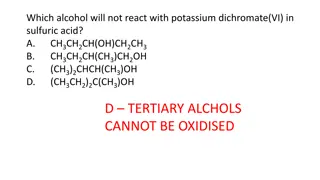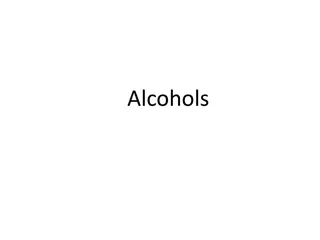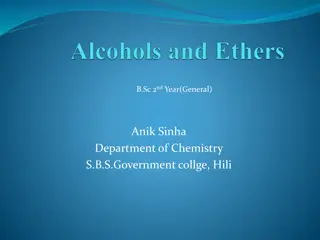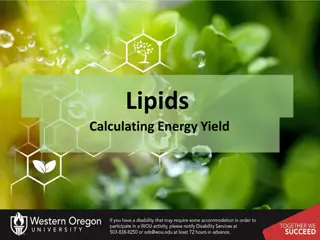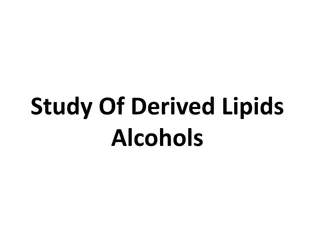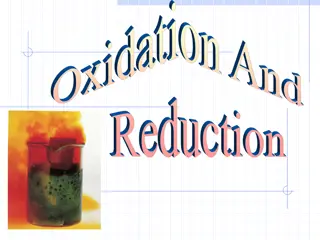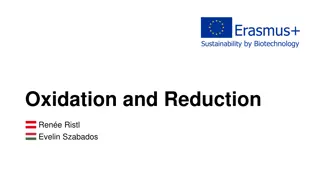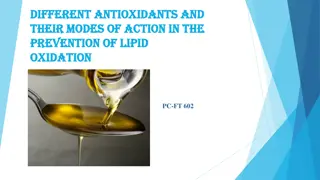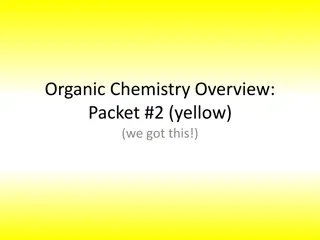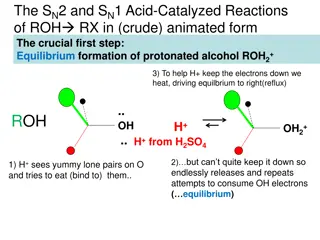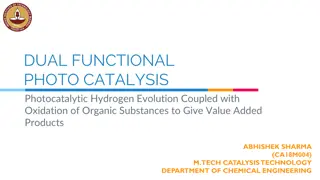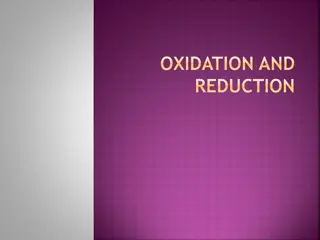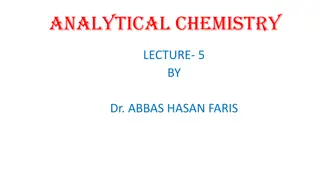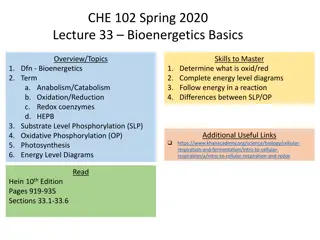Understanding Oxidation of Alcohols in Carbon Chemistry
Oxidation of alcohols involves either adding oxygen or removing hydrogen in carbon compounds, leading to the production of aldehydes, ketones, and carboxylic acids. Primary alcohols can oxidize further to produce aldehydes and carboxylic acids, while secondary alcohols form ketones. Tertiary alcohols do not undergo oxidation. Various oxidizing agents, like copper(II) oxide and acidified dichromate solution, drive these reactions. Understanding the principles of oxidation and reduction is crucial in exploring the diverse chemistry of alcohols.
Download Presentation

Please find below an Image/Link to download the presentation.
The content on the website is provided AS IS for your information and personal use only. It may not be sold, licensed, or shared on other websites without obtaining consent from the author. Download presentation by click this link. If you encounter any issues during the download, it is possible that the publisher has removed the file from their server.
E N D
Presentation Transcript
HIGHER CHEMISTRY UNIT 2: NATURES CHEMISTRY LESSON 2 OXIDATION OF ALCOHOLS By the end of this lesson you should know: 1.What is meant by the terms oxidation and reduction in carbon chemistry 2.The names of two oxidising agents for alcohols 3.That when some alcohols oxidise, they can produce aldehydes, ketones and carboxylic acids. Some alcohols do not oxidise. 4.How to draw and name carbonyl compounds, aldehydes and ketones.
Oxidation of Alcohols In carbon compounds, oxidation means either adding oxygen or removing hydrogen. i.e. increasing the oxygen to hydrogen ratio eg C2H4O2 (CH3COOH) C2H5OH C2H4O O : H 1 : 6 O : H 2 : 4 O : H 1 : 4 (= 1 : 2) The opposite of oxidation is Reduction. In organic chemistry, reduction is a decrease in the oxygen to hydrogen ratio, by either the addition of hydrogen or the removal of oxygen.
1. Oxidation of Primary Alcohols Primary alcohol ALDEHYDE C3H7OH Propan-1-ol C3H6O Propanal Can further oxidise to carboxylic acid
Aldehydes (Alkanals) Contain the carbonyl functional group at the end of a chain General formula CnH2nO eg. propanal : C3H6O Molecular formula: Structural formula: Shortened structural formula: CH3CH2CHO O at the end
2. Oxidation of Secondary Alcohols KETONE Secondary alcohol C3H6O C3H7OH Propan-2-ol Propanone Cannot further oxidise
Ketones (Alkanones) Contain the carbonyl functional group in the middle of a chain General formula CnH2nO (isomers of aldehydes) eg. Pentan-3-one : C5H10O Molecular formula: Structural formula: Shortened structural formula: CH3CH2COCH2CH3 O somewhere in the middle no bracket
3. Oxidation of Tertiary Alcohols Tertiary Alcohols
Oxidising Agents (for Alcohols) Oxidising agent Colour change hot copper(II) oxide Black to copper red Orange to blue-green acidified dichromate solution
1. Oxidation of ethanol (primary alcohol) using hot copper oxide copper(II) oxide colour change from black to red/brown ceramic wool soaked in ethanol HEAT universal indicator shows an acid is produced This reaction produces ethanal and ethanoic acid.
2. Oxidation of propan-2-ol (secondary alcohol) and 2-methylpropan-2- ol (tertiary alcohol) using acidified potassium dichromate. HEAT HEAT colour change from orange to green propan-2-ol in acidified dichromate solution 2-methylpropan-2-ol in acidified dichromate solution no oxidation occurs In this reaction, the secondary alcohol will oxidise to form propanone. The tertiary alcohol will not oxidise.
Oxidation Summary carboxylic acid Primary alcohol aldehyde No further oxidation ketone Secondary alcohol No Tertiary alcohol oxidation
NAMING ALDEHYDES AND KETONES Aldehyde 4-methyl pentanal CH3 CH3CH(CH3)CH2CH2CHO Ketone 5-methyl hexan-2-one CH3CH(CH3)CH2CH2COCH3
You should now know: 1. Oxidation increases the oxygen to hydrogen ratio 2. Oxidising agents for alcohols include: hot copper(II) oxide changes from black to red/brown acidified dichromate solution changes from orange to green 3. Primary alcohols can be oxidised to aldehydes and then to carboxylic acids 4. Secondary alcohols can be oxidised to ketones 5. Tertiary alcohols cannot be oxidised. 6. Aldehydes and Ketones are two homologous series, both with the general formula CnH2nO. 7. Aldehydes and Ketones both contain the carbonyl functional group, C=O.



